The business jet market is crowded, with multiple manufacturers vying for customers in various segments. With the exception of a large-cabin, long-range business jet, Cessna seemed to have all the bases covered.
The CJ line, model 525 in Cessna parlance, traces its roots as a replacement for the original Citation. Since the launch of the CJ1 in 1989, Cessna has fielded three other CJ models: the CJ2, CJ3 and CJ4. All four share the original Citation's fuselage cross-section and are powered by Williams FJ44 engines.
Cessna touts its Citations as a "sure thing", and you would be hard-pressed to challenge that. Citations may not be the most passionate business aircraft, but with more than 6,000 sold, Cessna has a large, loyal customer base.
With nine company-owned and 37 authorised service centres, Cessna can offer 24/7 support for Citation operators. To further meet the needs of its customers, it launched the largest and most capable CJ, the CJ4, in 2006.
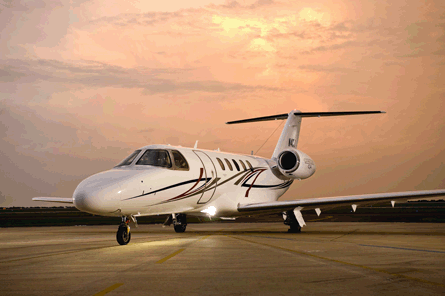 |
|---|
© Cessna |
Although the CJ4 shares a common fuselage cross-section and pilot type rating with its smaller CJ3 sibling, its longer fuselage and redesigned wing make it a more capable aircraft. It is 0.97m (3.2ft) longer than the CJ3, and the cabin is 0.51m longer.
That 0.51m is put to good use as the CJ4 has standard seating for eight - one more than the CJ3. Both aircraft have a club forward seating configuration, with two seats aft and a belted lavatory. The CJ4's extra seat is opposite the cabin entry door, next to a reasonably sized storage cabinet.
Seating can be boosted to nine by installing a two-seat divan in place of the single forward side-facing seat. The divan is a no-cost option, and when combined with the smaller storage cabinet, weighs 5kg (11lb) less than the standard configuration.
While the increase in cabin space is welcome, perhaps the most notable improvement with the CJ4 is its swept wing. Departing from the straight-wing CJ play book, the CJ4's wing is swept 12.5° at the 25% chord line, almost as much as the midsized Sovereign's 12.7°.
The swept wing allows the CJ4 to zip along at a high true airspeed cruise of 453kt (840km/h), 38kt faster than the CJ3. MMO for the CJ4 is also higher, 0.77 compared with 0.737 for the CJ3. The larger wing, 30.7m2 (330ft2) versus 27.3m2, also holds 2,645kg of fuel, 508kg more than the CJ3.
The extra fuel helps give the CJ4 an instrument flight rules range with six occupants of 2,000nm (3,710km), 260nm more than the CJ3. Although these comparisons with its stablemate are instructive, Cessna also ensured that the CJ4 was competitive with other manufacturers' offerings. The table below shows the CJ4 and Embraer Phenom 300 to have similar performance capabilities.
Cessna has made incremental changes to the CJ4's cabin, compared with the CJ3. While cabin width and height (1.47 x 1.45m) remain unchanged, the CJ4's interior detailing helps to increase passenger space. The ceiling valence is a lower-profile design, providing more headroom over the seats. Deft engineering allowed the sidewalls at foot level to be pushed out 5cm, giving more lateral legroom. The CJ4's seats are slightly lower than the CJ3's, again opening up more space.
The seat's armrests, towards the aisle, are a swing-arm design that offer a wider aisle while providing an equally comfortable seat. While these physical changes will be appreciated, the CJ4 offers other creature comfort improvements. A Rockwell Collins Venue cabin management system is standard in the CJ4.
MEDIA CENTRE
The Venue's media centre allows Blu-Ray/DVD/CD format media to be played, as well as files from the 100GB hard drive. A bulkhead-mounted LCD monitor and two 10.6in (27cm) moveable seat monitors are standard, with each seat equipped for a display. An Iridium satcom telephone is also standard kit in the CJ4's cabin. Rounding out the cabin's impressive features is a split-zone climate control system that allows the cockpit and cabin to be controlled individually, with passenger cabin settings controlled via a wireless remote.
Many CJ4 buyers are owner operators, and Cessna did not stop the upgrades at the cockpit. Like the CJ3, the CJ4 has a Rockwell Collins Pro Line 21 avionics system, but the CJ4's has four displays and an optional second flight management system. Each FMS incorporates GPS with wide area augmentation, as well as DME and VOR-derived positioning.
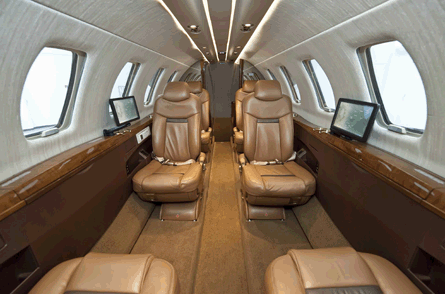 |
|---|
© Cessna |
The base-level CJ4 comes with impressive standard equipment, including terrain awareness warning and TCAS II systems. Cessna says a base-level Phenom 300 would require $400,000 in avionics options to match the CJ4's, albeit more expensive, avionics suite.
I have been impressed by the capabilities of Garmin G1000 and Prodigy avionics suites, but I still find their pilot interfaces lacking compared with the Pro Line 21. The Phenom 300 has a useful data entry keypad, but its functionality can't match a proper FMS.
Cessna has also raised its game with the CJ4's standard JeppView electronic charts and an electronic checklist.
After launching the CJ4 in October 2006, Cessna's development efforts reached certification on 12 March. Flight International was recently able to fly the third production aircraft at Cessna's Wichita production facility.
The safety pilot for the flight was Gregory Pavlish, Cessna's manager of flight operations. Alex Unruh, a Cessna demonstration pilot, accompanied us. The pre-flight inspection was straightforward. No ladders or steps were needed to accomplish required checks. The two external baggage compartments were easily accessible - the nose and tailcone compartments hold 182kg and 272kg, respectively.
Two new features highlighted by Pavlish were the CJ4's single-point refuelling capability and its standard lithium ion battery. The Li-ion battery weighs 15kg less than available lead acid or nickel cadmium products. For extreme cold weather operations, the Li-ion battery can easily be removed and stored in a warm place before reinstallation for flight.
New for the CJ4 is its machined cockpit entry door frame. Previous CJs had a stamped frame. The machined frame allows for tighter tolerances and a single static door seal provides good acoustic sealing.
 |
|---|
© Cessna |
Primary exit in the event of a ditching is the aft emergency exit, but a water barrier is also standard on the CJ4's forward entry door. Raising the barrier allows the door to be opened with the aircraft floating in water.
The interior of the preview aircraft was configured with the standard single seat opposite the entry door. As expected, the level of fittings was quite high. The cabin had LED lighting as well as electronic window shades. Window shades could be actuated at each seat or remotely via the Venue's remote control.
The cockpit is separated from the cabin by a curtain, allowing easy access. Referencing the pillar-mounted eye alignment balls, the four-way adjustable cockpit seat made it easy to find a comfortable seating position. The throttles fell readily to hand, but the control yoke sat a bit too high for my liking.
SINGLE-PILOT OPERATIONS
The forward instrument panel is arranged to facilitate single-pilot operations. Even with a maximum take-off weight of 7,690kg, the CJ4 is single-pilot certificated, as are all CJs. The flight guidance control panel is just underneath the instrument panel's glare shield.
The ProLine 21's four 200 x 250mm LCDs nearly cover the entire instrument panel; a single electronic standby instrument display and landing gear lever are centred between the displays. Outboard displays are set as primary displays, with the two centre ones configured as multifunction displays.
The inherent flexibility of the displays allow for dispatch with one display inoperative. The CJ4 has an engine indicating and crew alerting system (EICAS), which should be standard on an aircraft in this price range. System control panels are along the lower edge of the instrument panel and aligned to the left for ease of single-pilot operations.
Before-start checks were done by reference to a paper checklist. The standard electronic checklist was not fitted in our aircraft. FADEC-controlled engine start was a snap - each engine started with the push of two buttons. After-start checks were typical of a light twin jet, apart from the electrical system checks.
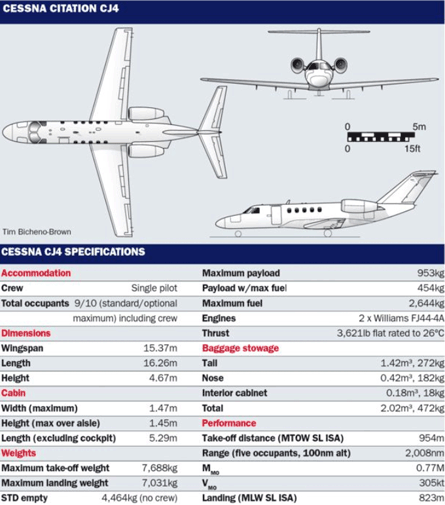 |
|---|
In addition to two engine-driven generators, the CJ4 has engine alternators, the main function of which is to power the windshield heat for the cockpit windows. In the event of a dual generator failure, they can also power the essential electrical bus via a transformer rectifier unit that converts AC to DC.
The quick alternator check ensured this valuable back-up would be there if we needed it. Although I had flown out of Wichita's Mid-Continent airport many other times, I found the JeppView airfield diagram greatly enhanced my positional awareness.
The CJ4 has a central 207bar (3,000lb/in2) hydraulic system to actuate the landing gear, flaps and wing-mounted speedbrakes, but, like other CJs, the CJ4 has an independent wheel brake hydraulic system. During the taxi out, I found the toe-actuated wheel brakes easily modulated taxi speed.
With 1,755kg of fuel and flaps set to 15° (take-off/approach setting), the 6,547kg Citation had take-off indicated speeds of 94/97/109kt (V1/VR/V2). Aligned on Runway 19L, I pushed the throttles forward to the take-off detent, a green "TO" indication in the EICAS display confirming full take-off power.
Acceleration was brisk, with the CJ lifting off the runway in a 10° pitch attitude. Cessna lists a take-off distance of about 975m for our conditions, a number confirmed by our short ground run. At maximum take-off weight and standard day sea level conditions, take-off distance is only 1,006m.
Once airborne, I retracted the landing gear, followed by flap retraction. Changing yoke forces during the clean up and acceleration were countered easily by the electrical elevator trim. I used the flight director flight level change mode to capture and track the initial climb indicated airspeed of 240kt as we turned towards the west for our climb.
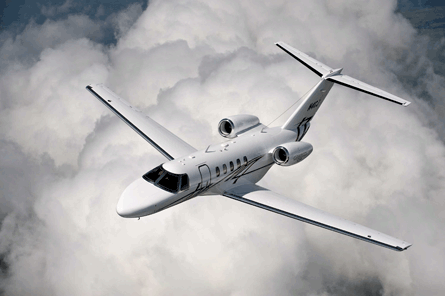 |
|---|
© Cessna |
After engaging the autopilot, I retarded the throttles to the climb setting, the FADEC keeping the optimum N1 set for the changing ambient conditions. On a hotter than standard day (ISA +18°C), we transitioned to an indicated climb of Mach 0.62, passing through 28,000ft.
The CJ4 levelled at FL400 about 21min after brake release with a total fuel burn of 250kg. In level flight, the throttles were retarded to the cruise setting, passing M0.75. The Citation settled into a M0.76 high-speed cruise condition, with a total fuel flow of 558kg/h giving a true airspeed of 440kt. The CJ4's listed maximum true airspeed of 453kt occurs at FL310. Next, the fuel flow on each engine was set to 172kg/h (344kg/h total) to approximate a long-range cruise condition.
As the aircraft slowed, I left the cockpit to sample the cabin's en-route comforts. The cabin floor was just a degree or so up at long-range cruise, allowing easy transit to the rear.
Ambient cabin noise level was fairly low, with the area opposite the entry door the loudest. I was easily able to carry on a conversation with Unruh as he expanded on some of the CJ4's features. The engines' FADECs have a feature that synchronises N1s to prevent the annoying reverberation heard with dissimilar engine settings. The improvements over the CJ3's cabin provided a more spacious interior. The Venue remote control device will please Alpha males in the cabin, with entertainment and comfort settings at their fingertips.
EMERGENCY DESCENT MODE
When I returned to the cockpit, I noted a cabin altitude of 6,600ft, the 0.6bar delta pressurisation system providing an environment on a par with civil airliners. Like several other Citations, the CJ4's autopilot has an emergency descent mode capability. If the cabin depressurises at altitude, the autopilot will start a descent to 15,000ft. As there is no auto throttle, it may take a while to reach the lower altitude, but the autopilot alone will get the aircraft going in the right direction.
The aircraft by then had stabilised at an indicated airspeed of 173kt, where the M0.586 cruise yielded a 339kt true airspeed. Compared with the high-speed cruise point, long-range cruise was about 100kt slower, but total fuel flow had dropped to 344kg/h. Long-range operations will certainly be at the slower cruise speed, but if a high-speed dash is needed, the CJ4 can do it, if you can afford the gas.
After the high-altitude work, I lowered the CJ4's nose for a high-speed descent to medium altitude. In the descent, we accelerated to M0.77 MMO, receiving both aural and visual indications of the impending overspeed.
At MMO, sharp inputs in each control axis elicited a dead beat response. Passing FL320 at an indicated airspeed of 285kt (VMO 305kt), I fully deployed the speedbrakes, the deployment of which can be modulated. Full speedbrake extension caused light buffeting and a slight nose-down pitching motion, countered by 4kg of aft yoke force. The aircraft was then slowed to an indicated airspeed of 250kt for the rest of the descent to 10,500ft, where I could further evaluate the CJ4's handling.
During the descent, I did a number of 45° and 60° angle of bank steep turns, with and without the yaw damper engaged. At medium altitude, the CJ4 was a pure joy to fly, with well harmonised aileron and rudder forces.
While at FL400, I had briefly hand-flown the aircraft. At altitude, some aircraft feel like they are balanced on the head of a pin - not unstable, but not rock steady either. At FL400, the CJ4 had felt solid and steady at the cruise conditions we sampled. Two approaches to stalls at 10,500ft further reinforced my feelings that the CJ4 had the best handling qualities of any Citation I had flown.
Both stalls, one in a clean configuration and the other with flaps set to 15°, were textbook affairs with no tendency to drop a wing at stickshaker activation. Recovery from both was accomplished by selecting take-off power and accelerating out in level flight.
With the medium altitude manoeuvres complete, we turned toward Mid-Continent airport for pattern work. Autopilot engaged, I followed air traffic control vectors to an instrument landing system final to Runway 19R. Pavlish helped me set up the box, the NAV radio autotuning the ILS frequency when the approach was selected and executed.
While still in a clean configuration on an extended final, I disengaged the autopilot and hand-flew the aircraft during configuration for landing. Slowing through an indicated airspeed of 180kt, the flaps were set to 15° and gear extended. Just before ground speed capture, flaps were set to 35° - the normal landing setting. Control force changes while slowing and configuring for landing were minimal, the pitch trim zeroing out pitch forces. Established on ground speed, about 62% N1 was needed on both engines to hold a target indicated airspeed of 111kt (reference plus 5kt).
Flight director guidance on final was easy to follow and I transitioned to visual references when "minimums" was announced. Passing about 30ft above the ground, I retarded the throttles to idle and initiated the flare manoeuvre at 10ft. After a smooth touchdown, I retracted the flaps to 15° and advanced the power for the "go" part of the touch and go.
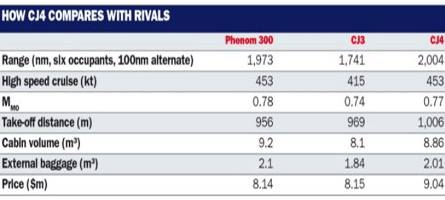 |
|---|
Pavlish called rotate at an indicated airspeed of 111kt and I established a take-off attitude of about 10°. Once airborne, Pavlish rapidly retarded the left throttle to idle, simulating a V2 cut. The CJ4 has a rudder boost system to aid control in the event of an engine failure, but it took most of the available rudder to keep the CJ4 tracking down the extended runway centre line on just the right engine.
I immediately retracted the landing gear, and retracted the flaps passing about 120kt. Initial climb performance was good, with full rudder trim alleviating most of the pedal force while at take-off power. Once level at pattern altitude and 180kt, less than 1/4 right rudder trim was needed to maintain co-ordinated flight with the asymmetric power condition.
Once established on a visual final for Runway 19L, with gear and flaps extended, I centred the rudder trim and was able to maintain co-ordinated flight with small rudder inputs. Even with just one engine, the CJ4 was easy to manoeuvre in the traffic pattern, another smooth touchdown delivered by the trailing link main landing gear.
LAST PATTERN
Both engines were used to accelerate the CJ4 for my last take-off. The last pattern was a visual one to a full stop landing on Runway 19L. Target indicated airspeed for the 5,740kg Citation was 110kt. Touchdown point was at the far end of the touchdown zone, and once alighted, I extended the speedbrakes. On the ground, as well as the two flight speedbrake panels on each wing, three large panels deploy to further reduce the landing roll.
Moderate toe braking, not cycling the anti-skid, rapidly brought the CJ4 to a safe taxi speed. The turn-off intersection was less than 1,000m from the runway threshold, and Cessna's listed landing distance of 823m seems realistic. During the taxi back to Cessna's parking ramp, I again found the JeppView airfield diagram a good aid to positional awareness.
My 2h preview flight in the CJ4 was a delight. Its handling qualities were the best of any Citation I had flown. More than a stretched CJ3, the CJ4's swept wing and expanded fuselage allow it to carry more further and faster.
Its common type rating with the CJ3 and single-pilot capability will make it a hit with owner operators. In broad terms, the CJ4's closest competitor is the Phenom 300, and many will doubtless opt for the Embraer.
I give the visceral edge to the Phenom. The CJ4 can carry more passengers and has a larger maximum payload, but costs more. They are two different, but highly capable, light jets.
With more than 150 orders booked for the CJ4, there seems plenty of room in the market for Cessna's largest Citation jet.
Source: Flight International
















